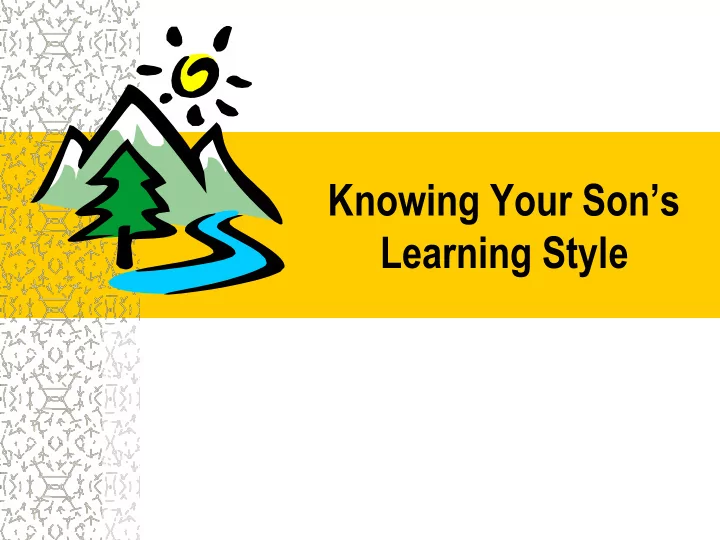

Knowing Your Son’s Learning Style
Objectives Know your son Strengths and Weaknesses in learning. Understand your children's learning needs Identify reasons for underachievement Student/teacher interaction improvement Aware that Learning Style can be changed
How we Learn To learn, we depend on our senses to process the information around us. Most people has a dominant style of learning
3 Major Learning Styles Visual (70%) Auditory (5%) Kinesthetic (25%)
Benefit of knowing your learning style For Students : • Important self-knowledge gained • Strengths and weaknesses in learning revealed • Self-esteem improved • Study skills enhanced • Misunderstandings with teachers and parents prevented • Liberated to study "your way"
Benefit of knowing your learning style For Parents : • Understand your children's learning needs • Identify reasons for underachievement • Remove barriers to your child's full learning potential • Communication with students improved • Less stress - day-to-day and in one-off situations
Visual Learning Style take numerous detailed notes prefer to sit in the front are usually neat and clean often close their eyes to visualize or remember something find something to watch if they are bored benefit from illustrations and presentations that use colour are attracted to written or spoken language rich in imagery
Auditory Learning Style sit where they can hear but needn't pay attention to what is happening in front hum or talk to themselves or others when bored acquire knowledge by reading aloud remember by verbalizing lessons to themselves like to have music when doing their jobs may not coordinate colours or clothes, but can explain why they are wearing what they are wearing and why
Kinesthetic Learning Style need to be active and take frequent breaks speak with their hands and with gestures remember what was done, but have difficulty recalling what was said or seen find reasons to tinker or move when bored rely on what they can directly experience or perform enjoy field trips and tasks that involve manipulating materials
Kinesthetic Learning Style (Cont’d) are uncomfortable in classrooms where they lack opportunities for hands-on experience communicate by touching and appreciate physically expressed encouragement, such as a pat on the back
Choice of words Visual Tinkling, silent, squeal, blast, screaming, choking Auditory Colour, clear, showed, vivid, notice Kinesthetic Felt, body sensations, feel, pain, touch
How they express their experiences (Visual) Have a sharp, clear picture of an experience. Eg. Can you see what I am saying? How do you see the situation? What do you see stopping you? This looks good. Do you see what I am showing you? You seem to be alright.
How they express their experiences (Auditory) Identify sounds related to an experience. Eg. I hear you clearly, I want you to listen . . . This sounds good What do you hear that is stopping you? Sounds heavy. You sound alright.
How they express their experiences (Kinesthetic) Develop a strong feeling towards an experience. Eg. Do you feel what you are saying? Are you in touch with what I am saying? How do you feel about this situation? I'm getting a handle on this material. Let's move together. Are you feeling alright? Sounds heavy.
Conflicts Why there are possible conflicts between mother and son? What you told your son may work against you!
Conflicts Your style Your son’s Conflict style Auditory Kinesthetic “Son! Why are you not listening when I talk to you?” [Kinesthetic using feel to communicate] Visual Auditory “Ai Yah!!! You never pay attention to what I say!” (Auditory doesn’t make eye contact) Kinesthetic Auditory “You are insensitive!” [Auditory by listening, not feel] Kinesthetic Visual “You are insensitive!” [Visual by looking, not feel]
Area for Improvement Everyone has a mix of learning styles. Some people may find that they have a dominant style of learning, with far less use of the other styles. Others may find that they use different styles in different circumstances. There is no right mix. Nor are your styles fixed. You can develop ability in less dominant styles, as well as further develop styles that you already use well.
Thank You for your Time!
Recommend
More recommend